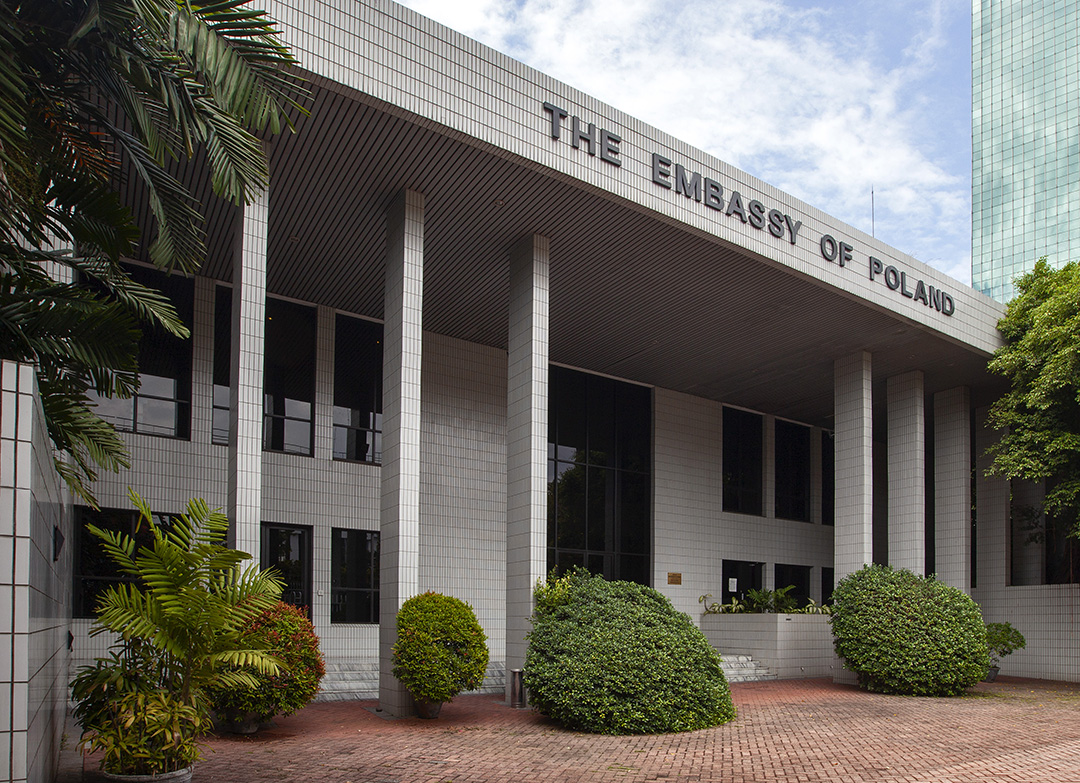Story by Iman Hidajat | Photos by Bagus Tri Laksono
H.E. Beata Stoczyńska is an Ambassador of the Republic of Poland to Indonesia, who loves a wide range of contemporary arts and designs, from a collection of Krosno Glass to the paintings by Jerzy Nowosielski, a famous painter from her homeland Poland. She lives in an official residence, tucked away in the Embassy’s compound in Kuningan, Jakarta. She welcomed Indonesia Design with a friendly smile.
Entering the compound, one can’t help but notice the showcase of the Bauhaus architecture’s straightforward shapes painted with basic industrial white-to-beige colour schemes. The design aims for the embassy building’s cohesion, simplicity and functionality. “Welcome to the Embassy of Poland,” greeted Ambassador Beata. “To the left is our diplomatic office, but let’s come here to the residence,” asking us to follow her to the residence’s open door.
The Embassy of the Republic of Poland lies on the 6,805 square metre-plot of land in Jakarta’s golden triangle area. Purchased by the Polish government in 1986 from PT Town and City Properties, the building process had not started until about ten years later, in 1995. The architecture of the building was conceived by the Polish architectures, Andrzej and Barbara Kaliszewscy, Bohdan Napieralski, from KANA Architekci sp. z o. o. with PT International Design Consultants as its local partner up to the middle of 1998 and PT Meinhardt from 1998 until completion in the same year. The Ambassador’s official residence is a two-storey and box-shaped building whose façade is decorated with six pillars that stand symmetrically to the left and right of the residence’s entrance. Beata started to occupy this modernist- style building, her official home, following her appointment as Polish Ambassador to Indonesia and accredited to East Timor and ASEAN in February 2018. In the house, she invites guests and holds diplomatic dinners.
Upon entering the residence, we were amazed with the building’s Bauhaus modernist-looking architecture and excited with the residence’s warmth and welcoming ambiance. A foyer, decorated with a classic European long chair with large European Union and Polish national flags displayed regally on the right corner, symbolizes guests’ arrival at an official residence. A beautiful dark brown panelled stairway to the second floor graced the room, lighted with a sleek-looking crystal chandelier. Guests will be welcomed by sitting areas to the left and right of the room, overlooking a terrace with sofas facing the lush landscaped tropical garden. Glassware pieces, which decorate the sitting room, steal the spotlight. The pieces are produced by KROSNO, the world-famous Polish glass brand. The brand, a synonym for best quality since 1923, is the largest glassware manufacturer in Poland. With nearly 100 years of excellent craftsmanship renowned for its attention to detail, KROSNO has become an icon in Polish glassware.
Beata also mentions her favourite Polish painters, whose paintings adorn the surrounding walls of her official residence. One of them is Jerzy Nowosielski, a Krakow-born Polish painter, graphic artist, scenographer, and illustrator whose works of art are Poland and Ukraine’s common heritage and pride. Inspired by the Byzantine heritage and referring to his sacred and secular works, Nowosielski took over the atmosphere of ambiguity and mystery from surrealism. Nowosielski was also well known for his religious composition in the Eastern Orthodox Churches in several cities in Poland.
We walked towards the ground floor of the residence, the foremost part that plays the diplomatic role. On the right side of the room lies a dining area with a long table that can seat 16 guests, where various formal dinners with European sophistication ambiance are customarily held. On the far side, guests can spot the statues of two prominent Polish musicians: Fryderyk Chopin, a composer and virtuoso pianist of the Romantic Period, and Krzysztof Penderecki, a composer, and conductor.
Looking out the tall windows, guests can also see another building in the back of the compound. Beata explained that the embassy features three main buildings: the embassy office, the official residence, and the apartment for the Polish diplomats working in the embassy. “We call it a campus,” she said. The compound or the so-called ‘campus’ radiates this sense of grandeur integration between the architectural shape of the buildings and the well-landscaped garden with long-shaped water fountains as the focal perspective in the middle. In front of the apartment building, there is an L-shaped swimming pool, shaded with lush tropical trees, a centre of leisure activities. Beata invited us to enter the embassy building, where we visited her office and a vast library, which also functions as a gathering room. Every corner of this embassy is adorned with works of art, mostly by Polish artists. Modern art is everywhere in Poland, the Ambassador said. It is like part
of Polish life; you can meet artists and art enthusiasts in many places in Poland. Ultimately, Poland combines classic and modern art, foods, and architecture well, making it an exciting country to visit, she concluded.
